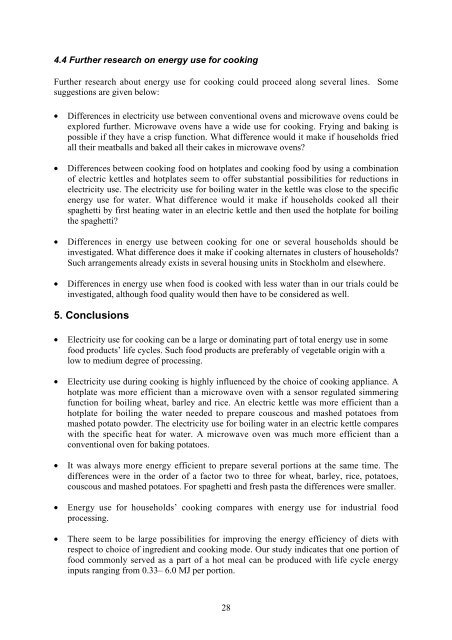Energy Use for Cooking and Other Stages in the Life Cycle of Food
Energy Use for Cooking and Other Stages in the Life Cycle of Food
Energy Use for Cooking and Other Stages in the Life Cycle of Food
You also want an ePaper? Increase the reach of your titles
YUMPU automatically turns print PDFs into web optimized ePapers that Google loves.
4.4 Fur<strong>the</strong>r research on energy use <strong>for</strong> cook<strong>in</strong>g<br />
Fur<strong>the</strong>r research about energy use <strong>for</strong> cook<strong>in</strong>g could proceed along several l<strong>in</strong>es. Some<br />
suggestions are given below:<br />
• Differences <strong>in</strong> electricity use between conventional ovens <strong>and</strong> microwave ovens could be<br />
explored fur<strong>the</strong>r. Microwave ovens have a wide use <strong>for</strong> cook<strong>in</strong>g. Fry<strong>in</strong>g <strong>and</strong> bak<strong>in</strong>g is<br />
possible if <strong>the</strong>y have a crisp function. What difference would it make if households fried<br />
all <strong>the</strong>ir meatballs <strong>and</strong> baked all <strong>the</strong>ir cakes <strong>in</strong> microwave ovens?<br />
• Differences between cook<strong>in</strong>g food on hotplates <strong>and</strong> cook<strong>in</strong>g food by us<strong>in</strong>g a comb<strong>in</strong>ation<br />
<strong>of</strong> electric kettles <strong>and</strong> hotplates seem to <strong>of</strong>fer substantial possibilities <strong>for</strong> reductions <strong>in</strong><br />
electricity use. The electricity use <strong>for</strong> boil<strong>in</strong>g water <strong>in</strong> <strong>the</strong> kettle was close to <strong>the</strong> specific<br />
energy use <strong>for</strong> water. What difference would it make if households cooked all <strong>the</strong>ir<br />
spaghetti by first heat<strong>in</strong>g water <strong>in</strong> an electric kettle <strong>and</strong> <strong>the</strong>n used <strong>the</strong> hotplate <strong>for</strong> boil<strong>in</strong>g<br />
<strong>the</strong> spaghetti?<br />
• Differences <strong>in</strong> energy use between cook<strong>in</strong>g <strong>for</strong> one or several households should be<br />
<strong>in</strong>vestigated. What difference does it make if cook<strong>in</strong>g alternates <strong>in</strong> clusters <strong>of</strong> households?<br />
Such arrangements already exists <strong>in</strong> several hous<strong>in</strong>g units <strong>in</strong> Stockholm <strong>and</strong> elsewhere.<br />
• Differences <strong>in</strong> energy use when food is cooked with less water than <strong>in</strong> our trials could be<br />
<strong>in</strong>vestigated, although food quality would <strong>the</strong>n have to be considered as well.<br />
5. Conclusions<br />
• Electricity use <strong>for</strong> cook<strong>in</strong>g can be a large or dom<strong>in</strong>at<strong>in</strong>g part <strong>of</strong> total energy use <strong>in</strong> some<br />
food products’ life cycles. Such food products are preferably <strong>of</strong> vegetable orig<strong>in</strong> with a<br />
low to medium degree <strong>of</strong> process<strong>in</strong>g.<br />
• Electricity use dur<strong>in</strong>g cook<strong>in</strong>g is highly <strong>in</strong>fluenced by <strong>the</strong> choice <strong>of</strong> cook<strong>in</strong>g appliance. A<br />
hotplate was more efficient than a microwave oven with a sensor regulated simmer<strong>in</strong>g<br />
function <strong>for</strong> boil<strong>in</strong>g wheat, barley <strong>and</strong> rice. An electric kettle was more efficient than a<br />
hotplate <strong>for</strong> boil<strong>in</strong>g <strong>the</strong> water needed to prepare couscous <strong>and</strong> mashed potatoes from<br />
mashed potato powder. The electricity use <strong>for</strong> boil<strong>in</strong>g water <strong>in</strong> an electric kettle compares<br />
with <strong>the</strong> specific heat <strong>for</strong> water. A microwave oven was much more efficient than a<br />
conventional oven <strong>for</strong> bak<strong>in</strong>g potatoes.<br />
• It was always more energy efficient to prepare several portions at <strong>the</strong> same time. The<br />
differences were <strong>in</strong> <strong>the</strong> order <strong>of</strong> a factor two to three <strong>for</strong> wheat, barley, rice, potatoes,<br />
couscous <strong>and</strong> mashed potatoes. For spaghetti <strong>and</strong> fresh pasta <strong>the</strong> differences were smaller.<br />
• <strong>Energy</strong> use <strong>for</strong> households’ cook<strong>in</strong>g compares with energy use <strong>for</strong> <strong>in</strong>dustrial food<br />
process<strong>in</strong>g.<br />
• There seem to be large possibilities <strong>for</strong> improv<strong>in</strong>g <strong>the</strong> energy efficiency <strong>of</strong> diets with<br />
respect to choice <strong>of</strong> <strong>in</strong>gredient <strong>and</strong> cook<strong>in</strong>g mode. Our study <strong>in</strong>dicates that one portion <strong>of</strong><br />
food commonly served as a part <strong>of</strong> a hot meal can be produced with life cycle energy<br />
<strong>in</strong>puts rang<strong>in</strong>g from 0.33– 6.0 MJ per portion.<br />
28
















